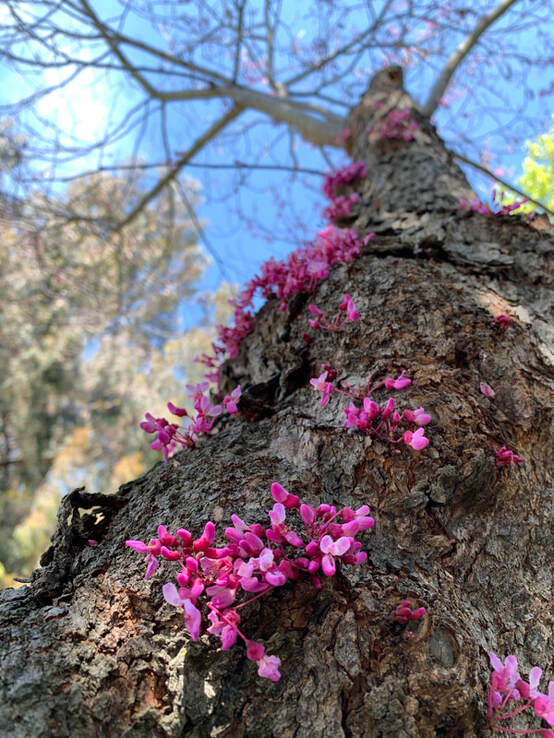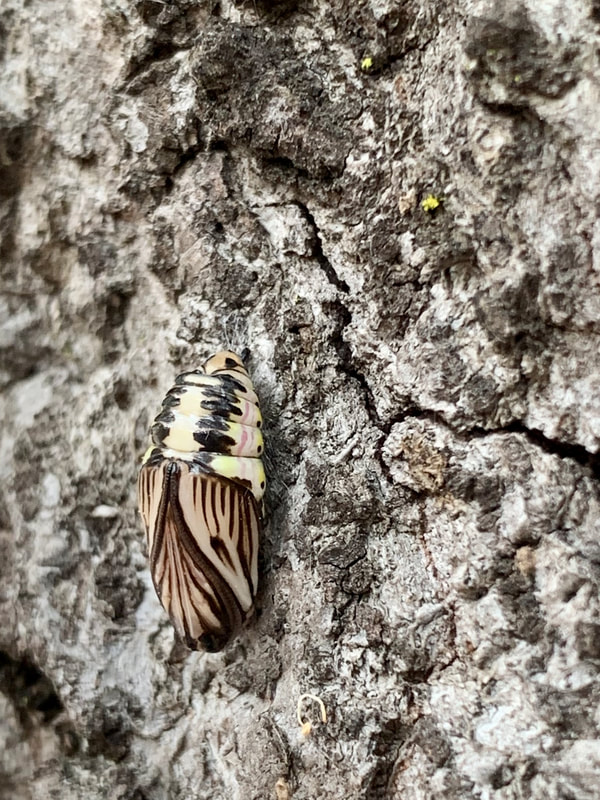What is a Naturalist?Since most of us are staying close to home this summer, we cannot widely explore, but we can deeply observe―with all of our senses― the natural beauty in our own backyards. In fact, I’ve taken the opportunity to become a better backyard naturalist, and I invite you to join me. When you hear the word naturalist, what do you think of? Charles Darwin investigating the flora and fauna of Galapagos islands back in 1835? Your birder aunt updating her detailed spreadsheet with this year’s avian sightings? The park ranger who led an interpretive hike in Yellowstone National Park on your last family vacation? Perhaps you do not even have an image to call up. Well, quite simply, a naturalist is someone who spends time in nature making observations and asking questions. Anyone can develop the mindset, and skill set, of a naturalist! Moreover, there is a robust body of research on the many benefits of spending time in nature. I will get you started by sharing a few of my recent experiences and some relevant National Geographic Education resources. Find a "Backyard" for ObservationsBeing a backyard naturalist is a great solo, family, or physically-distanced activity. I have really enjoyed the time alone, sometimes with my toddler son, exploring my backyard― about an acre of garden and oak forest in Palo Alto, California. If you don’t have a backyard, you can seek out a nearby green space or park. Somewhere close to home is great because you can quickly make some observations if time is limited. With better access, you can also vary the time of day when you can make observations, which is really useful in recognizing patterns like which wildlife are active during the day (diurnal), at night (nocturnal) or dusk and dawn (crepuscular). If you live in a city, you can use National Geographic Education's Finding Urban Nature Resource Library to help find opportunities for naturalist activities in an urban setting. Document ObservationsOne of the most important aspects of being a naturalist is documenting our observations. This could take different forms, depending on your interests. I am partial to iPhone photography, and I have included some of my insights on composition in the captions of the photographs included here. For more tips, check out Nat Geo Kids’ Take Awesome Outdoor Shots and 5 Wildlife Photography Tips. You might create a nature journal and include original sketches and annotations. Take note of the weather conditions. Think about what other quantitative and qualitative data you might include in your journal entries. Remember to include sensory details: compare the underside of the leaf to a familiar texture; explain how the air smelled after the rain; and transcribe that melodic chickadee call you heard. Beautify your nature journal with some flower or leaf pressings. Consider choosing a “sit spot” that you revisit for observations, and it may illuminate changes over time. Select one plant or square meter of land, for example, and carefully document it through the seasons. To aid your observations, you may want to acquire tools like binoculars, hand lenses, bug cases, or field guides, but they are not required to get started. So. Many. Questions.Remember, being a naturalist involves asking questions about our observations. One of the most simple ones, about an organism, is: “what is that?” Certainly, names have importance and learning to identify species is a useful skill, but it should be just the beginning of your inquiry. Naturalists wonder about about natural phenomena they witness. They ask questions concerning ecology, that is, about all the complex interactions among living things and their environment. Questions might include: why are some squirrels grey and some black?; how is that gall wasp parasitic?; what trees do woodpeckers prefer?; how does fungus pop up after a rain?; which flowers attract the most butterflies?; and why do I only hear owls at night? Sometimes the answers are revealed through systematic observation, but often the questions spark interesting research. For example, I saw tiny purple blooms growing right out of a tree trunk! It appeared to be cauliflory, when plants flower and fruit from their trunks or main branches. Yet I was only familiar with cauliflorous tropical plants like cacao, breadfruit and papaya. When I did some research, I found out that redbud trees (Cercis) like this one are fantastic local examples of cauliflory. This evolutionary trait allows trees to have their seeds dispersed or be pollinated by animals that can’t fly or climb. Looking High, Low, Close, and FarYou should visualize your backyard or other green space as a three-dimensional ecosystem like in this "Who's in My Backyard?" infographic by National Geographic Education. The infographic is helpful in that it highlights energy flow in feeding relationships. You might observe evidence of these feeding relationships firsthand; recently, I saw a jackrabbit munching on grass and I later found the scat of a coyote containing jackrabbit fur. The infographic also serves to remind us that when observing, we need to make a conscious effort to vary our perspectives to fully investigate all aspects of the space. Look high in the sky to see the hawk slowly gliding. Look low to see the tiny banana slug leaving its slime trail across the ground. Look close to discover the intricate moss growing on your back patio. Look far to spot the skittish white-tailed deer at the edge of the meadow. Keep looking. Recently, in late afternoons, I had observed swarms of moths fluttering in the canopies of my oak trees. I wondered if they were a threat to the tree health and why they were so active during the day. I could not get a great look at the moths at that height, but I decided to look closer at the tree. Clinging to the tree bark, I saw a boldly marked chrysalis that reminded me of a tiny painted bead. The creature metamorphosing inside that protective shell was a native California oak moth (Phryganidia californica). I did some research and found out that when they are in caterpillar form, a large population of oak moths can defoliate entire oak trees. However, the oaks are able to bud and produce new leaf systems and are not usually destroyed by the voracious eaters; the species have co-evolved as part of the same oak woodland ecology here in northern California. Also, most moths are nocturnal, but these oak moths produce a chemical defense against bird predators, which is why they are out during the daytime.. Uncovering HabitatSome habitats need to be uncovered, such as by turning over rocks and logs. For example, after hearing its call for weeks, I finally found a Pacific treefrog (Pseudacris regilla) this spring. Despite their name, they live on the ground; in fact, this camouflaged beauty was hiding under a rotting log. Their coloration is highly variable: bright green, tan, grey, brown or even black. Individuals can even change colors in a matter of minutes to months, depending on conditions. Recently, I lifted a log to reveal a wriggling golden treasure trove of salamanders. The slender salamanders (Batrachoseps), endemic to different regions of California, are small-limbed and mainly stay nestled in leaf litter and eat insects. Lungless, they breathe through their moist skin. Amphibians such as frogs and salamanders are important 'indicator species' of ecosystem health because they are especially sensitive to environmental changes. Remember, it is extremely important to re-cover any habitat you have uncovered. If you flip a log or rock over to inspect what's beneath it, then put it back in place to protect the creatures living there. Surveying LifeWhen you are ready to develop your species identification skills, you'll have to look closely at morphological characteristics of the organism (size, shape, structures); details like type of leaf margins, number of appendages, and position of color bands become critical. Why not use your smartphone to enhance your learning? I highly recommend the app iNaturalist, as it provides an online community of naturalists and the ability for any registered user to upload observation photos with locations. iNaturalist observations are organized in various projects, confirmed by expert naturalists, and are a form of citizen science― meaning the data collected by members of the public is used in actual scientific studies! Kids need parental permission to use the iNaturalist, but there's also a cool version for younger users called Seek. It has a gamification that can be appealing- like Pokemon but with nature. Another great citizen science all, specifically for bird identification, is eBird; use it to upload and log your own bird observations and find bird hotspots documented by the eBird user community. As a naturalist, one question you might ask yourself is “How many different species are in my backyard?” One awesome citizen science activity to help answer that question of backyard biodiversity is to conduct a biological survey of an area in a specified period of time. It's called a BioBlitz! The goal is to identify and document as many different species as possible, and you can record the data in your nature journal or with iNaturalist. Find detailed instructions for conducting one in National Geographic Education’s Backyard Bioblitz. When I conducted a backyard BioBlitz, I catalogued almost 100 species of animals and plants. Not surprisingly, the most animal diversity was among the insects; I identified red skimmer dragonflies, sweat bees, pill bugs, blister beetles, carpenter ants, yellow-faced bumblebees, painted lady butterflies, Jerusalem crickets, and so many more. Going FurtherThere are lots of different opportunities to grow as naturalists. Attracting wildlife means more wildlife observations, but it also can help conservation efforts. A fun family project might be setting up a bird feeder, a hummingbird feeder, or bat house. You could plant a native garden to welcome pollinating bees and butterflies. Finding a community of like-minded naturalists is another more social option. Local nature centers are great resources for lectures, guided hikes, and other activities once things start to open back up. Almost every US state has an official Master Naturalist program that offers courses and certification!
|
AuthorThis blog contains occasional dispatches from my science classroom and professional learning experiences. Thank you for reading! Archives
December 2021
|
|
Cristina Veresan
Science Educator |
Proudly powered by Weebly
|










 RSS Feed
RSS Feed